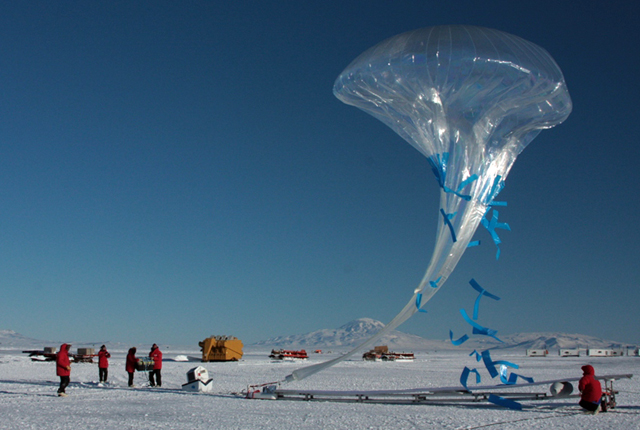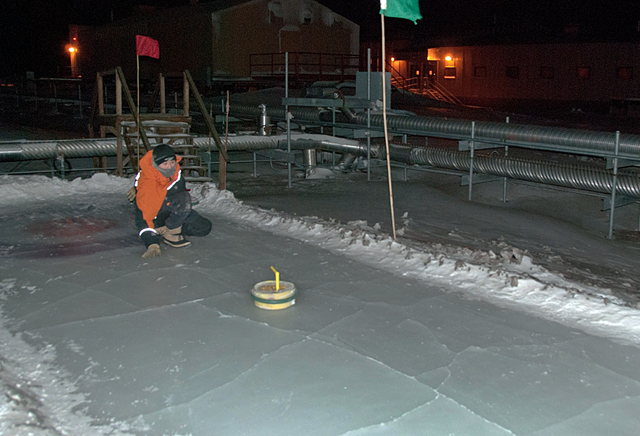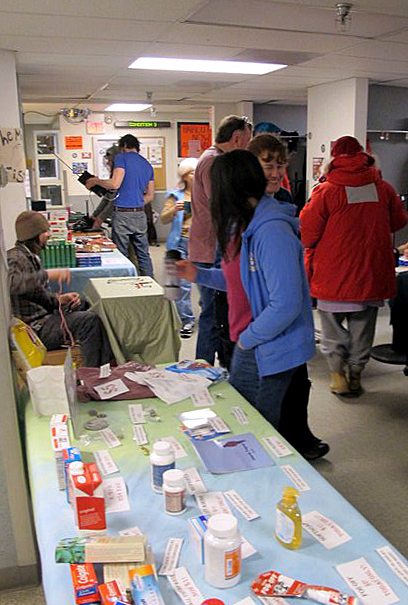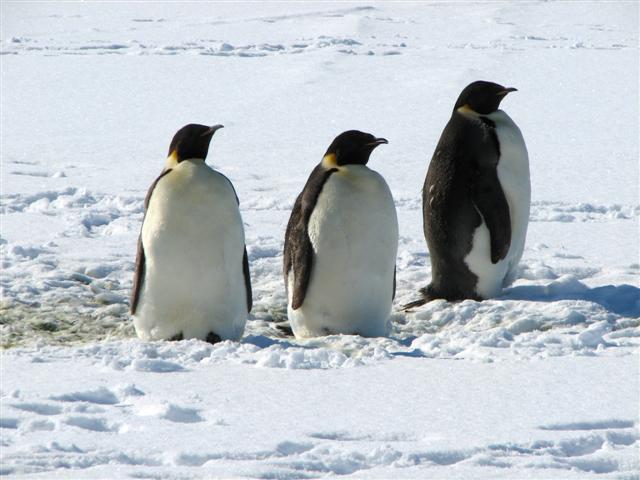|
McMurdo Station Archives - 2010 Fast-paced season ensures plenty to see and do at McMurdoPosted November 26, 2010
I take a seat in the crowded dining hall and stare out the window, past the rivers of meltwater flowing through channels in the streets carefully carved by Fleet Operations, and watch the routines of McMurdo Station Helicopters lift off past Observation Hill, hauling sling loads of gear for field camps. Science groups in snow-covered Pisten Bulleys return home from an overnight trip on the tracked vehicles. Station personnel in Carhartts walk about in the bright sunshine. Summer is in full swing on Ross Island. The Sea Ice Runway has welcomed hundreds of people since it opened in October, swelling station population to almost 1,100 even as groups have passed on to the field camps, the South Pole Some groups, such as the French Concordiasi Also leaving us this month was Antarctica’s first female chaplain, Laura Adelia, who was pinned as a lieutenant colonel upon her arrival at McMurdo. She returns to her congregation in Arizona. Science continues, however. The science team of Robert Garrott of Montana State University The penguins are looking good as well. A group led by Paul Ponganis, with Scripps Institution of Oceanography Team members are now camping out at Cape Washington, where they have successfully deployed recorders and transmitters on the penguins to help in the study of their physiological ecology. And while they have not yet seen any leopard seals, which they would like to tag for another part of their research, they have seen evidence of them. 
Photo Credit: Stacy Kim/Antarctic Photo Library
Scientists prepare to deploy SCINI through the ice into McMurdo Sound during a previous field season.
Another team is sending a remotely operated vehicle called SCINI (Submersible Capable of under Ice Navigation and Imaging) Some lucky people who are not directly connected to the scientists have had opportunities to partake in morale trips, heading out with groups into the field to assist in dive tending, or shovelling snow, or what might be a once-in-a-lifetime opportunity to go ice fishing at the base of Mount Erebus. A very tired but excited firefighter, Jeff Kennett, exclaimed excitedly upon his return from his working day trip that he “didn’t catch the most fish, but I caught the first fish, and the last fish.” Another recreational activity causing quite a stir is the return of the Observation Tube, a metal cylinder with an observation port at the bottom, which was inserted into the sea ice. It allows visitors to descend below the level of the ice and have a look around in the sea, a view that is almost always reserved for the divers. Visitors have been lining up around-the-clock for a chance for this unique opportunity, and faces flush with excitement report seeing seals swimming close by — a rare opportunity to view these animals in their native environment. Next up for McMurdo is Thanksgiving Dinner, coming up on Saturday, Nov. 27. The kitchen crew puts everything on the line for this, the most anticipated meal of the season. It’s a chance for the cooks to showcase their abilities and talents and to shine for the community. From my seat at the dining hall window, I’ll watch as the unwary with blue trays full of delicious leftovers try to dodge the opportunistic skuas. Field camps start to pop up as ice pier work continuesPosted October 29, 2010
Scientists and support personnel continue to pour into McMurdo Station The largest field program in the early part of the season is nearly complete. The French-U.S. Concordiasi project A group from the University of Wyoming Meanwhile, nearly 50 people are in eight field camps near McMurdo Station. Science teams include researchers studying the population dynamics of Weddell seals from a location called Big Razorback and divers studying a strange microbial ecosystem in an ice-covered lake in the McMurdo Dry Valleys In town, work continues on a new ice pier when the previous structure unexpectedly cracked and separated at the end of the 2009-10 summer season after all the vessels had departed. McMurdo Fleet Operations developed a technique to relocate the broken pier using the wind and tide for controlled drifting so work could begin this past winter on a new pier. The ice pier is a one-of-a-kind creation — essentially a huge, steel-cable-reinforced, floating ice cube. It was built for the first time at McMurdo in 1973 by the U.S. Navy. Six piers have been built since then. The latest had been in operation since 1999. [See story in Jan. 8, 2006 issue The pier accommodates the annual cargo re-supply vessel and a fuel tanker, along with icebreakers and research vessels. The USAP will continue its push to become more energy efficient this season with the testing of two electrical vehicles around McMurdo. Last season, in collaboration with the Antarctica New Zealand McMurdo Station throws open the doors to summerPosted September 24, 2010
Busy is the one word that could be used to describe August at McMurdo Station With a final wave to winter came a bevy of greetings. Hello to the sun, hello to a new U.S. Antarctic Program The first flight of Winfly, short for “winter fly-in,” arrived Aug. 15. It was notable because it marked the first ever night-vision-goggle flight involving passengers. Over the last two years, the U.S. Air Force has flown several practice night flights to prove that the large C-17 Globemaster III planes can be used safely to move passengers and cargo at any time of the year. [See related article: Night vision.] More than a week earlier than years past, the flight kicked off one of the busiest Winfly periods in McMurdo history. Traditionally, Winfly consists of a small number of flights in late August to bring in extra supplies and people to help de-winterize the station and prepare for the summer season. This year, however, seven flights over two weeks brought 400 new support personnel and scientists, and about 400,000 pounds of cargo. The population swelled from 198 — people thrown together for six months of winter isolation — to 526 people. The max population in summer is about 1,100 at McMurdo. The winter crew did much of the job de-winterization the buildings — cranking on the heat, troubleshooting furnaces — in late July and early August. That allowed the fresh crew to hit the ground running to support some logistics-heavy science during the late Antarctic winter. This Winfly there are three projects involving more than 30 National Science Foundation 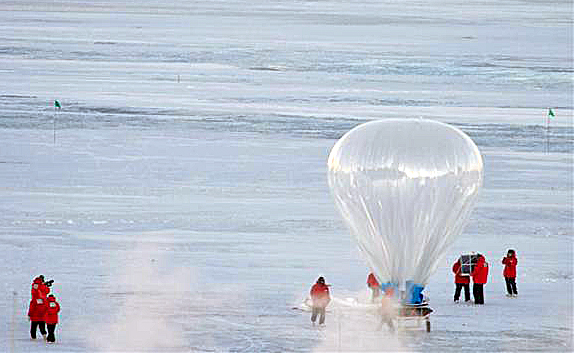
Photo Credit: Holly Troy/Antarctic Photo Library
Scientists launch the first Concordiasi balloon from the sea ice near McMurdo Station.
The research during Winfly ranges from atmospheric measurements to monitoring seal behavior. The biggest science group represents the Concordiasi project Their research consists of deploying multiple large balloons high into the air that carry instruments that measure the troposphere and stratosphere, the lowest two levels of the atmosphere. One main goal is to validate data already collected from a polar-orbiting satellite by calibrating it with the data collected from sensors on the balloons. Other balloons will carry instruments to study the role of nacreous clouds in ozone depletion. These high-elevation clouds only form in the extremely cold temperatures found during the Winfly season, and fill the sky with streaks of color rivaling any sunrise or sunset. About 18 balloons will be launched from a camp very close to station, allowing McMurdo residents to get a firsthand look at science at work. [See related article: Flying high.] Terry Deshler’s Finally, back for a third season, is a group of researchers studying the diving and hunting patterns of Weddell seals in low-light conditions. Given that Winfly still has periods of sunlight and darkness, this is the only time that this research can take place at McMurdo short of spending the winter. The team has already successfully caught five of nine planned seals. They collect individual biological data on the animals before securing monitoring cameras to their backs to further study their habits after release. [See related article: Night hunt.] Weather has once again played a major role in Winfly operations. While it is a much proven fact that weather on Ross Island is at its worst during the months of August and September, it is still impossible to predict exactly how or when this bad weather will manifest itself. This year brought near-record snowfalls, high winds and cold temperatures. A storm on Aug. 25 dumped 6 inches of snow in a 24-hour period, nearly beating the decades-old record of 6.2 inches set in 1966. The lowest recorded temperature for August was minus 71 degrees Fahrenheit with wind chill. While not a record, the storm did wreak havoc on the flight schedule, causing multiple delays, as we waited for the snow and winds to calm down, and for the heavy equipment operators to clear the runway and roads to the airfield. Despite the challenges of weather, everyone has managed to work around these setbacks to prepare for the onslaught of summer. Olympic curling comes to McMurdo StationPosted August 27, 2010
McMurdo Station A chili cook-off pitted local chili masters against one another, with the blue ribbon going to Pat Gilmor from the supply department. Dining hall staff provided a bevy of familiar carnival foods, including corn dogs and funnel cakes, and there was even cotton candy provided by the UT Shop from the very first Antarctic cotton candy machine made from old parts. In yet another tradition, winter-overs donated items and services for an auction to benefit the community. The proceeds go to purchase winter hats and T-shirts designed by local artists, as well as for door prizes and beverages for the end-of-season winter party. In a wonderful act of charity, station manager Jeanne Suchodolski pledged to match all auction profits in a donation to the Red Cross. The evening wrapped up with live music from many of the winter bands, and revelers danced late into the evening. Although fireworks are not allowed on continent, research assistant Jason Bryenton organized a special firing of the Lidar laser into the night sky, as a close second to this great American tradition. Not to be outdone by the Fourth of July, store manager Keri Nelson, along with a group of dedicated volunteers, organized a street fair that was held outside of the store in the station’s main building one Sunday afternoon. The street fair was coordinated with the store’s end-of-season sale and included jugglers and other buskers, appearances by local “celebrities” handing out autographs, a live radio show, and many arts and crafts stalls highlighting the work of local artists. Even though it took place in a hallway, the volunteers managed to capture the feeling of a busy street market, and everyone had a great time. July also featured the unveiling of the first-ever curling rink in Antarctica. Designed and built by volunteers over the winter, the scaled-down version of a standard curling rink now exists outside next to Gallagher’s pub. Complete with curling stones and brooms, the inaugural match brought out many residents to learn the secrets of this mysterious sport in which players slide stones across a sheet of ice toward a target area. Several McMurdo teams competed for the honors of representing the station in the first-ever international Antarctic curling championship against New Zealand’s Scott Base After an afternoon of raucous play, including a hot cocoa break at the half, McMurdo claimed the right as Ross Island curling champions for this winter season, with a final score of 8 to 4. The month wrapped up with an end-of-winter bash. Held in multiple locations across the station, the party was organized to allow winter-overs to enjoy each other’s company in a relaxed yet festive atmosphere one last time before the influx of new people during the Winfly season. The evening’s festivities included a beer tasting of New Zealand brews, finger foods provided by the kitchen staff and a variety show featuring poetry, stand-up comedy, skits and music. All of this, and we managed to prep the station for an early August arrival of scientists and support crews during that time between summer and winter seasons known as Winfly. Dorms and other buildings that had been winterized all season have been re-heated and opened for business to meet the demands of the 400 new residents who began arriving Aug. 15 when the first flight touched down at Pegasus airfield We have lost the peace and quiet of winter, but the payoff is the arrival of old friends and fresh faces — and all of those delicious fresh fruits and vegetables. McMurdo residents shake it up for youth educationPosted July 23, 2010
For a slow month, June managed to creep up on McMurdo Station 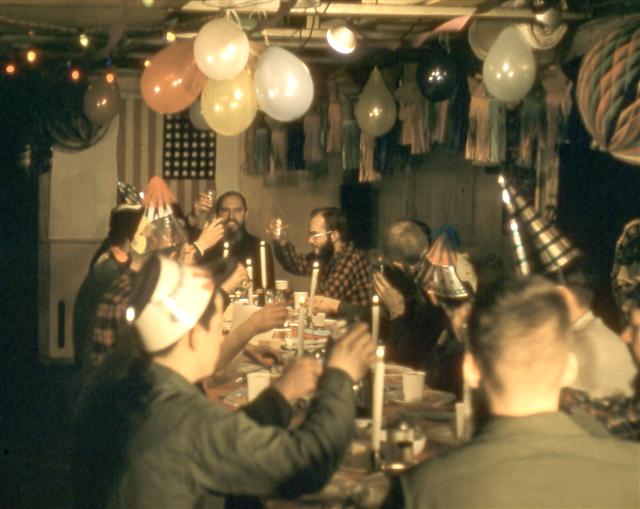
Photo Credit: Cliff Dickey/Antarctic Photo Library
Men at the South Pole Station celebrate Midwinter Day with a feast in 1957.
The Midwinter celebration is a holiday unique to those wintering at bases on the Antarctic continent and the subantarctic islands. Held on June 21, the day of the winter solstice, Midwinter celebrates the completion of the first half of the winter season and the start of the slow return of the sun. At McMurdo Station, the highlight of the celebration is a night of fine dining and dancing, taking place in the decoratively transformed dining hall. Residents helped in all areas of preparation, including decorations, music, photography, food preparation, dishwashing duties, volunteer organization, and setting up and breaking down the dinner festivities. The night commenced with appetizers, as folks gathered to nibble on the hors d'œuvre and sip on wine, served by volunteers. Serenaded by the musical stylings of Fleet Ops’ own Jason Barcomb, it was a chance for people to mingle and appreciate their co-workers dressed in their finest attire. As always, the kitchen staff outdid themselves with the dinner offerings. A selection of cold salads included a buffet of fresh vegetables from the greenhouse, as well as cold duck breast salad on toast. The main entrees had something for every palette, including Beef Wellington, stuffed lobster tail, and a delectable veggie entry. Desserts were a work of art by master baker Josie McLeod — pyramids of chocolate mousse, platters of hand-dipped truffles in every flavor, puff pastries with cream, and even homemade ice creams and sorbets. Dinner was followed by dancing and revelry, as McMurdo residents took a moment from their busy work schedules to enjoy the company of their fellow winter-overs and celebrated the passing of darkness into light. However, Midwinter celebrations did not cease with the end of the music or the transformation of the elegant dining hall back into a kitchen galley. The festivities continued the next weekend with the annual midwinter run. Although only a brief 1.4-mile course, the race is a tradition that brings with it the rigors of winter. Racers must dress for unpredictable winter weather and navigate the all-dark course with the help of flashlights and headlamps. A long-held tradition, the race signifies the winter-over spirit and the commitment to not just sit dormant while the sun is below the horizon. This year’s race brought out about 11 volunteers and 22 hearty souls of all abilities for the 10 a.m. start. The final results had Matt Cherf (Fuels department) as the overall male winner with a time of 9:05 and Cathy Morrell (UT shop) as the overall female winner with a time of 9:42. Whether fast or slow, running or walking, all the participants enjoyed the opportunity to get outside and compete under the stars. The passing of midwinter means that we have gone about five months without mail. However, McMurdo residents were treated to package deliveries courteous of the U.S. “Penguin” Service. Interested folks signed up and created anonymous packages filled with goodies found in their rooms or in "skua," the local depository for items that people no longer need but are still useful. Packages were “mailed” over a two-day period, and then received from the recreation office. Package mail items ranged from hand-knit hats, fancy chocolates and other food items, toys and other gag gifts. It was a great treat to receive and open mail in the middle of the winter season. 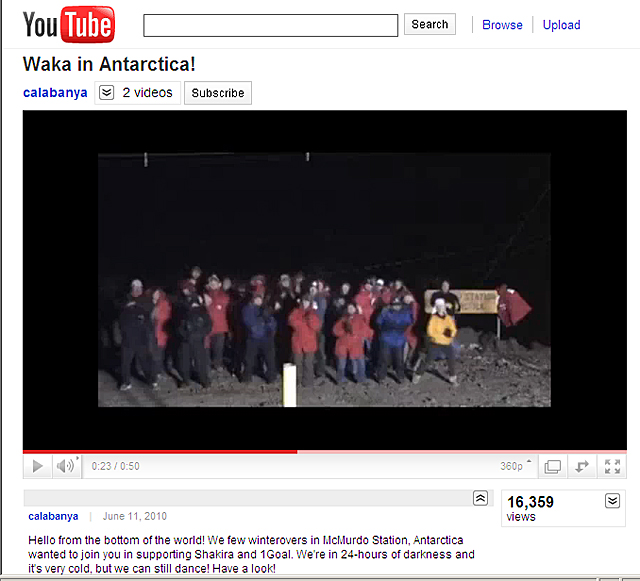
Screenshot of YouTube video showing McMurdo Station residents dancing to Sharkira's song "Waka Waka - Time for Africa."
Although far away from most of the current events of the rest of the world, McMurdo residents were bitten by the World Cup bug as well. Using a random-number generator, each resident on station was assigned to one of the teams participating in the soccer matches. Having a particular team to root for made following the games all the more exciting. Games were broadcast both on the regular TV channels and also shown in lounges and bars where larger groups could gather. Due to the time difference, some diehard fans were meeting as early as 6:30 am to watch some of the key matches. The group assigned to the winning team were awarded prizes from the recreation office. Along with following the different national teams in the soccer competition, a large group of music and dance lovers participated in the 1Goal: Education for All The group recorded and uploaded a video of themselves to YouTube Being the only post from Antarctica, the YouTube video garnered a great number of hits (16,000 and counting), and even received special comments from Shakira herself. Winter mixes recreation and work at McMurdo StationPosted June 11, 2010
May came in fast — and passed by even faster here at McMurdo Station Auroras have begun painting the sky with a dancing array of colors, and the Southern Cross dutifully points south on clear days, reminding us just where to look when giving a nod to our South Pole This month brought many opportunities for us to mingle with our Kiwi neighbors over the hill at New Zealand’s Scott Base 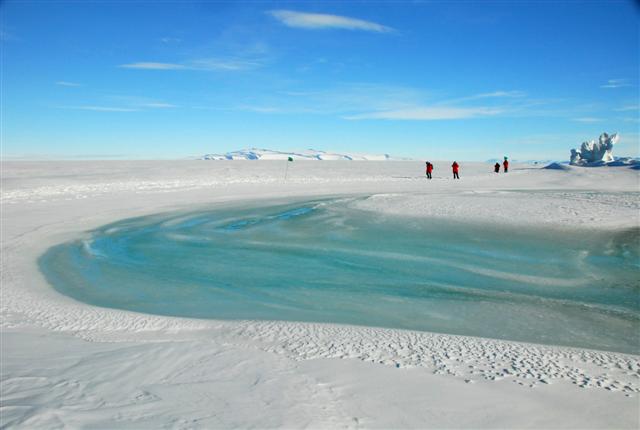
Photo Credit: Robyn Waserman/Antarctic Photo Library
The area off-shore New Zealand's Scott Base has pressure ridges and open water where the permanent ice shelf pushes up against the shore ice.
At the end of April, McMurdo residents were invited to a ceremony at Scott Base to commemorate ANZAC day — the New Zealand alternative to Memorial Day, which honors New Zealand and Australian military that served and died at Gallipoli, Turkey, as their first major action during World War I. This is an important national celebration, and it was an honor and a privilege to help them celebrate such a sacred day. In a more celebratory fashion, there was a strong Kiwi contingency at McMurdo Station for the station’s inaugural beer-tasting festival. The tasting featured eight beers and one cider, which were all brewed in New Zealand. These beers, which are not available for purchase in the McMurdo store, were a treat for all and an opportunity to once again experience a piece of New Zealand culture. Festivities continued throughout the month with several themed parties, including the Famous Dead People’s Ball and the Space Party. The Dead People’s Ball has become an annual tradition at McMurdo Station, where people dress up as someone who is both famous and dead, and each year brings some radical costume ideas. The Space Party, held at Scott Base with an intergalactic theme, featured live music from some of the multiple bands that have formed this winter. With a large pool of talent this season, the bands covered all genres, from original rock to country, and played late into the evening. While everyone on station found plenty of recreational opportunities to stay busy during off-hours last month, plenty of time was spent on topics of a different sort. Preparation and planning to refine our Comprehensive Emergency Management Plan (CEMP) continued to be a station-wide effort. The winter-over population came out in full force to take on a challenge by station management to bring our preparedness to a new level. When asked to put in the time commitment to complete Incident Command System (ICS) training courses offered online by the U.S. Federal Emergency Management Agency The inclusion of ICS and the appropriate training is a mandatory part of the mass casualty plan, as set forth by the federal government; however, completing the training was done on a voluntary basis. The fire department has also begun offering CPR and First Aid training classes twice a month. 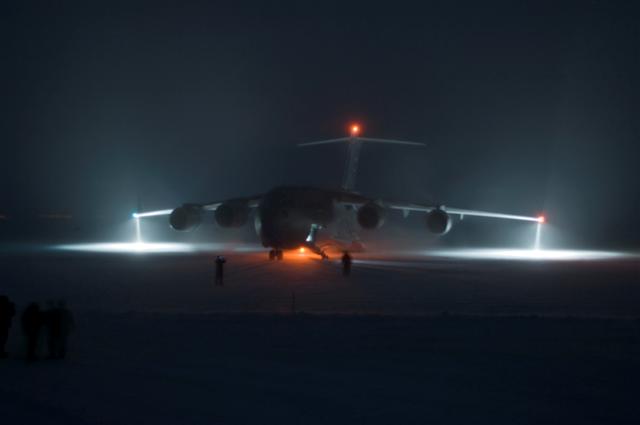
Photo Credit: Bill Henriksen/Antarctic Photo Library
An Air Force C-17 Globemaster III at Pegasus Airfield in August 2008 after the first successful night-vision goggle mission on the Ice.
With May behind us and June fast upon us, the days are moving quickly for this winter-over population. Just recently, we learned that Winfly, the period when the first wave of flights arrive, will begin on Aug. 13. That’s about a week or so earlier than normal, necessitating the use of night-vision goggle missions by the U.S. Air Force out of Joint Base Lewis-McChord This announcement brought with it both joy and trepidation, as everyone took stock of how fast time is moving. In just over two months, old friends and new ones, in a flurry of action and summer preparedness, will greet us. Whether we look forward to the influx of new faces or are looking for the best place to hide, one thing remains certain for all who are wintering: The end is in sight, and we can begin making travel plans! Good neighbors and good times over the hill at Scott BasePosted May 14, 2010
April 27 marked the final sunset over McMurdo Station However, although the sun has officially disappeared from view, long twilight continues to fill the sky with color and paint the mountains of the Royal Society Range across McMurdo Sound with pinks, oranges and golds. The daylight hours are decreasing rapidly, and months of darkness will soon wrap McMurdo but not without one last vision of nature’s beauty. The final sunset was celebrated by all with a sunset posted hosted by New Zealand’s Scott Base 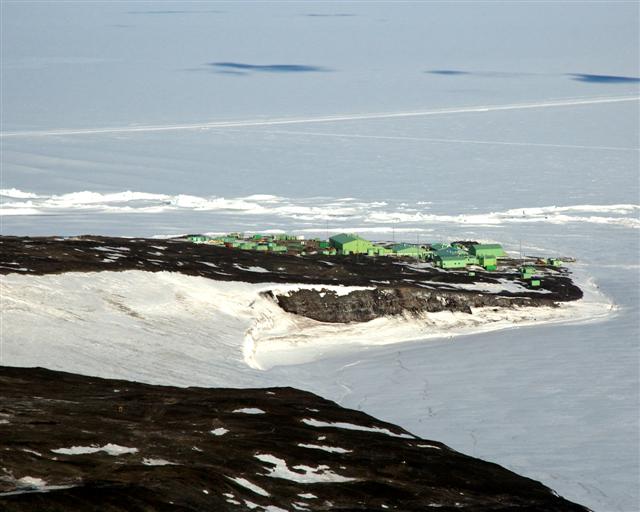
Photo Credit: Timothy Russer/Antarctic Photo Library
Scott Base, home to the Antarctica New Zealand program.
Along with the inevitable slide into darkness, April also brought with it a McMurdo Station first: the inaugural Store Fashion Show, put on by store manager Keri Nelson and a large crew of creative volunteers. Highlighting the works of fictional designer “McMurdo,” the evening event showcased an array of new items that arrived on the annual resupply vessel in February and that will be available for purchase in the station store over the next several months. All the stops were pulled to put on this gala affair, with video productions, “on-scene” media reporting live from the red carpet, and over a dozen volunteer models showing off hats, T-shirts, sweatshirts and other souvenir items. The creativity and hard work of many winter-overs went into making this a night to be remembered — and hopefully a night to be repeated in years to come. McMurdo Station winter-overs enjoyed a two-day weekend last month as well. The normal weekly work schedule runs from Monday through Saturday, with only one day off each week. However, the winter schedule allows for one full weekend a month for workers to relax and recoup, as a way to compensate for the many holiday weekends that are overlooked due to the load of winter tasking that must be accomplished. Once again, much of the community celebrated picnic-style at the Vehicle Maintenance Facility, as they enjoyed barbeque, chili, and a double-elimination horseshoe tournament that took up most of the day. This is a fine way to spend a relaxing day with friends. 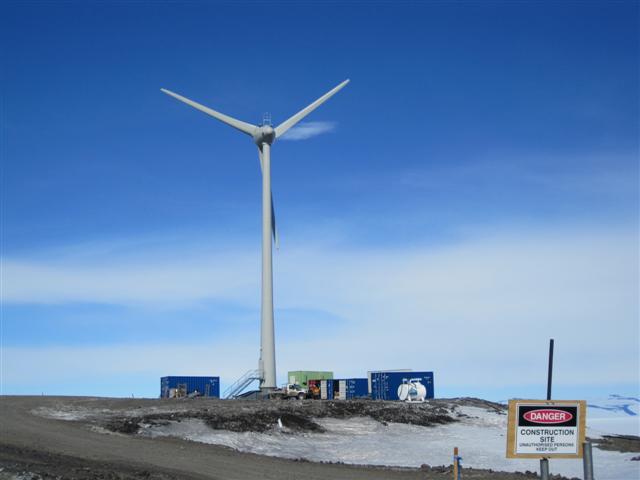
Photo Credit: Chris Wilson/Antarctic Photo Library
One of three wind turbines shared by the U.S. and New Zealand Antarctic programs for power generation.
Winter-overs have also begun to develop new friendships with our neighbors over the hill at Scott Base. Located just three miles from McMurdo Station, the New Zealand base offers McMurdo winter-overs an opportunity to make international friends, as well as a place to escape for a bit of a change. Relations with the members of the Scott Base community are always close, with the two stations sharing power-making capabilities and other operations. In the winter, the smaller community size allows for more mixing and mingling on a social basis as well. Along with being frequent participants in the social events at McMurdo Station, every Thursday, the Kiwi base — ironically enough, only populated by four New Zealanders out of the 13 base members this winter — hosts “American Night,” for members of the McMurdo community. Each week a small group joins the Kiwis for a delectable dinner in their galley, and then the base store and lounge are opened up for the whole McMurdo community to visit for the remainder of the evening. This is a wonderful chance for members of both communities to meet and share stories, building friendships that will last well beyond the confines of winter. McMurdo Station winterized and ready for the long nightPosted April 23, 2010
On March 5, 2010, the final flight of the 2009-10 summer season left McMurdo Station 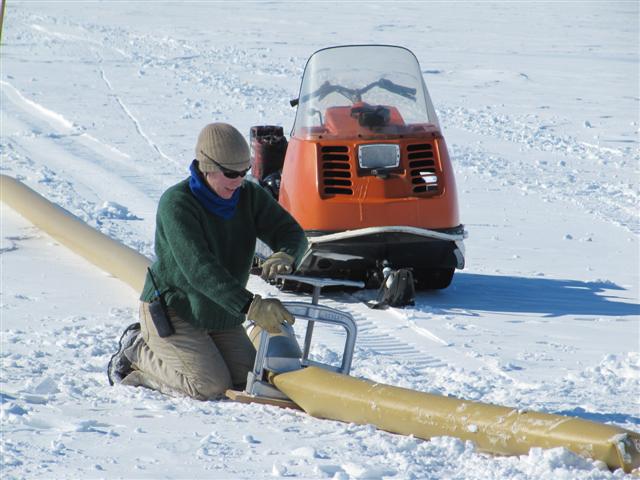
Photo Credit: Jennifer Kemper/Antarctic Photo Library
Fuels operator Lisa Keller clamps a fuel line that runs to Pegasus Airfield.
The primary goals of this extended season were to roll up the nearly 14 miles of fuel line stretching from the station to Pegasus Airfield After waving goodbye to the final flight, the remaining 198 winter-over personnel got to work. Standard winter tasking is moving along rapidly, with many departments working hard to collect, inventory and repair all the materials needed for summer science. For example, the staff at the Berg Field Center, a science support center responsible for all materials issued for living and working in summer field camps, will spend the winter carefully inspecting tents, stoves, sleeping bags and other field materials to make sure that they are ready to issue to scientists upon their return. In turn, the mechanics at the Mechanical Equipment Center, another science support center, are moving through their winter tasks: performing preventive maintenance and repairs on bigger items such as skidoos, field generators and heaters. Recreational activities are at full blast, thanks in part to the addition of a winter recreation coordinator this winter. We celebrated St. Patrick’s Day with a four-mile Leprechaun fun run in the morning, kicked off by the appearance of Fire Capt. John Cassidy dressed as a leprechaun. The day ended with an Irish-themed party in the evening, complete with bagpipes. 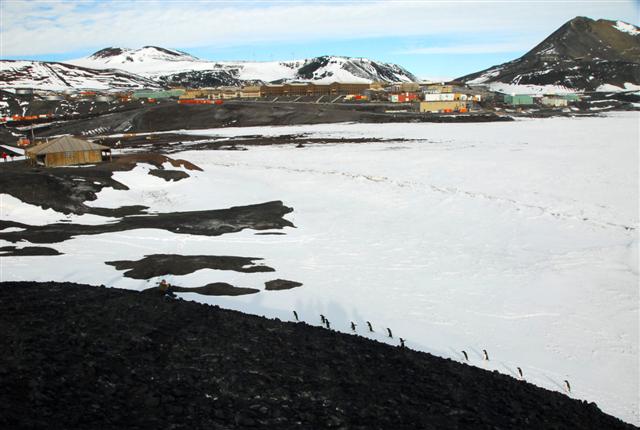
Photo Credit: Robyn Waserman/Antarctic Photo Library
A line of Adélie penguins is spotted near McMurdo Station in January 2010.
The annual wine tasting was also a success, offering winter-overs the opportunity to meet and mingle while sampling vino from New Zealand. Held each year in the library, the tasting featured community musicians and fine foods provided by the dining staff. There is a strong focus on health and wellness this season. In addition to the standard yoga and Pilates classes, more unique offerings include fencing, international dance, Zumba and poi spinning. Zumba, a cardio class that mixes Latin dance moves with cardio exercise, is a popular class, meeting twice a week and drawing a very diverse crowd of followers. To help people create and meet their own personal health and fitness goals, various groups have formed to support weight loss and fitness advances. McMurdo’s version of the popular TV challenge “Biggest Loser” attracted almost 15 percent of the population, with 27 people competing to lose the largest percent of weight during the eight months of winter. The McMurdo Fitness Club includes some of the “Biggest Loser” participants but also involves many people looking to improve their physical fitness without a weight loss component. In keeping with the focus of station wellness, training began this month for Mass Casualty Incident (MCI) preparedness. An MCI is any emergency event that may occur on station that would tax the resources of the full-time emergency team, which consist of the medical staff and the fire department. In the event of such a major emergency, volunteers would assist in all areas of response, such as stretcher-bearers or on the trauma team. Teams have met for individual training and organization, and will come together frequently over the winter to run through drills. Currently, there are 88 winter-overs training to be ready to serve the community. Days are getting shorter as the final sunset in April fast approaches. Winter-overs are taking the time to enjoy the last vestiges of the Antarctic daylight with recreational trips for prime sunset viewing. Soon, the sun will set, the stars will be out, and the ghostly Aurora Australis will appear — a spectacle to keep drawing us outdoors until the sun reappears in August. McMurdo Station bids farewell to last summer flightPosted March 19, 2010
“Wheels up on the last flight!” bleeped the radios, and soon the Australian Airbus flew close enough to McMurdo Station 
Photo Credit: Wally Walker
The last flight of the 2009-10 season leaves Antarctica on March 5, 2010.
Whoops, cheers, (tears?) followed the plane into the blue from the 70 or so people gathered for the send off. Then came looks — hard looks — around as the realization hit: these are the furry faces, the windblown cheeks and runny noses we’ll be seeing for the six months. After the March 5 flight, there will be no more flights to McMurdo Station until August. The final tally on the winter population, according to Karen Robinette of Human Resources, shakes out to 198 people. Forty-seven women and 151 men. This will be the first Antarctic winter for about a third of the population, while more than 60 percent weathered winters before. Three dormitories are open to accommodate the population, with pleasant perks like wireless Internet and having one’s own room — unheard of in the crowded summer season. No longer are there lines for computers or laundry, and you don’t have to look both ways before crossing “Highway 1,” the central hallway in the station’s main building. Dining hall lights are dimmed to natural light only, a setting called “winter lighting” as the station ekes out what’s left of the sunshine before darkness takes hold April through August. But while life has quieted, the work pace keeps cranking along. 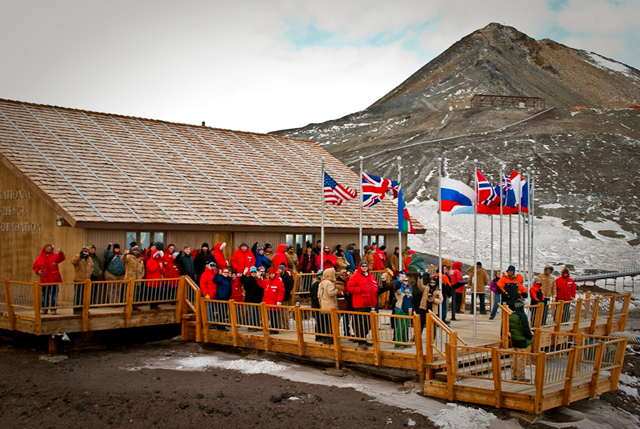
Photo Credit: Wally Walker
People at McMurdo send off the March 5 flight from the deck of the McMurdo Station chalet.
According to Station Manager Jeanne Suchodoski, key winter tasks include the repair and return to service of machinery in preparation for the summer science season. Receiving inventory must be completed after February’s weeklong cargo vessel offload. The heat trace project, funded by $3 million in stimulus money, continues to work on installing thermostatic controls along six miles of pipeline to keep water from freezing. The $5 million Mogas (motor gasoline) upgrade will continue to rebuild the fuel system with the hopes of doubling the station’s fuel capacity in case of a failed ship re-supply. Another preventive project is the power plant upgrade to add redundancy to the current system — where a failure can mean shutting down a portion of the station. The new power plant will also capture more heat and use less fuel, according to the National Science Foundation Office of Polar Program’s Hard work in the cold means hearty appetites, and special attention was given this year to keeping McMurdo’s greenhouse operating and ensuring imported fresh food stays around longer. According to Kitchen Supervisor/Chef Justin Lardy, the dining hall ordered 660 pounds of waxed apples, 210 dozen eggs, and fresh cream, which can last four to six months. In the event more people enjoy that cream over apples, McMurdo is offering its own version of the “Biggest Loser” weight-loss competition. However, girth and growth are encouraged in the winter’s traditional mustache growing contest. What’s an Antarctic winter without a lot of furry faces to look at? End-of-season ops under way at McMurdo StationPosted February 5, 2010
The rumor raced through McMurdo Station This, alas, was a hopeful wish born of Attenborough’s mid-month visit, though it wasn’t long before the legendary man held court on birds-of-paradise and other adventures during a presentation to a packed crowd of star-struck wildlife lovers. Attenborough was in Antarctica for a new BBC/Discovery documentary series called Frozen Planet, which focuses on the polar regions. [See previous article: Frozen Planet.] 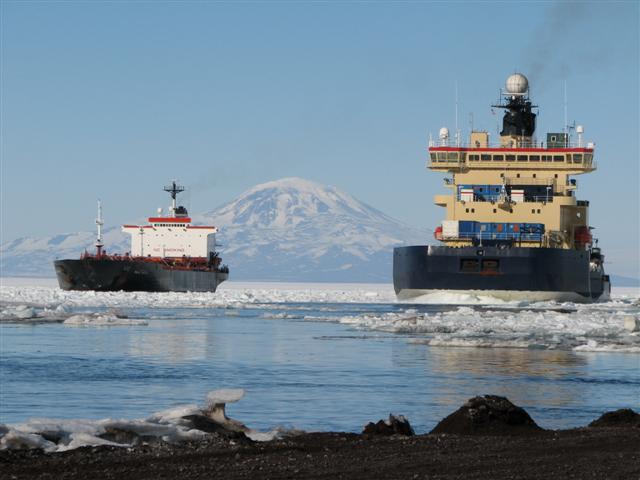
Photo Credit: Chris Demarest/Antarctic Photo Library
The Swedish icebreak Oden clears a channel for the MV Paul Buck fuel tanker ship.
Wildlife lovers had a great month all around, as open water in front of McMurdo brought penguins a plenty to town. Whale spouts were visible from bayside windows, and four Adélie penguins even crossed the finish line along with 67 participants in the annual marathon race on the ice shelf. Swedish icebreaker Oden appeared on the horizon in early January and cut wide swaths in the sea ice, creating a channel for the MV Paul Buck tanker ship that arrived for a fuel delivery. The tanker brought 4.6 million gallons of AN-8, 350,000 gallons of JP-5, and 115,000 gallons of MOGAS, according to the Fuels Department. The offload took about 38 hours. The cargo vessel, which carries most of the food and materials for McMurdo and South Pole The station population continued to fluctuate as field camps began breaking down and closing for the season, and winter-overs started trickling in to prepare for the long, dark night. Warm weather blessed annual Icestock music festival, as 16 bands rocked the stage — outdoors in front of happy hula-hoopers, robots, ninjas and regular folk — and indoors to packed, energetic dancers. Another lovely warm day set the annual McMurdo/Scott Base Weather didn’t matter for Freezing Man — McMurdo’s answer to the Burning Man festival in the Black Rock Desert of Nevada. The party included dancing, various performances and costumes. Nor did weather matter for the McMurdo Film Festival, which held the crowd rapt with films like “The Beauty of a Harsh Continent” and “Pizza.” McMurdo residents catch some rays as summer heats upPosted January 8, 2010
Brats sweated on a charcoal grill. Batters took their practice swings and fielders tossed the ball around. A megaphone-wielding janitor kept a running patter for the fans. A typical summer scene — except for the baseball mitts stuffed with hand-warmers and the ballfield of volcanic rock. Scores of people played ball at McMurdo Station’s 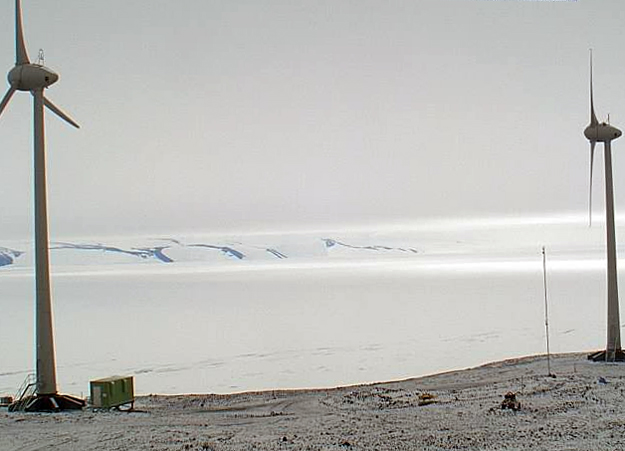
Photo Courtesy: Meridian Energy and Antarctica New Zealand
A Webcam shows two of the three new wind turbines near McMurdo Station.
Folks cruise around on bicycles with skis strapped to their backs or squeeze in rounds of Frisbee golf. In just two days over the Christmas holiday, some 60 hikers took to the Cape Armitage and Castle Rock trails. Another 15 skied 13 miles back from the Pegasus air field Warmer weather brings significant changes to the local landscape, as the Scott Base Adélie penguins skirted the station around Hut Point on Christmas. Other visitors this month included a group of 108 cruise ship tourists who stopped at McMurdo Station during a month-long voyage on the Russian icebreaker Kapitan Khlebnikov. The international tourists rode by helicopter to McMurdo, received a tour of the station and visited nearby Scott Base. The station also got a lesson in conservation Dec.19 when bars closed early and residents unplugged their coffee pots, refrigerators and computers for a five-hour maintenance on a diesel power generator. Said FEMC Maintenance Manager David Zybowski, “The load shedding went better than expected.” Three wind turbines are also spinning away on Crater Hill in a multi-national project between Meridian Energy and Antarctica New Zealand |
Home /
Around the Continent /
McMurdo Station Archives - 2010
"News about the USAP, the Ice, and the People"



For USAP Participants |
For The Public |
For Researchers and EducatorsContact UsNational Science FoundationOffice of Polar Programs Geosciences Directorate 2415 Eisenhower Avenue, Suite W7100 Alexandria, VA 22314 Sign up for the NSF Office of Polar Programs newsletter and events. Feedback Form |


